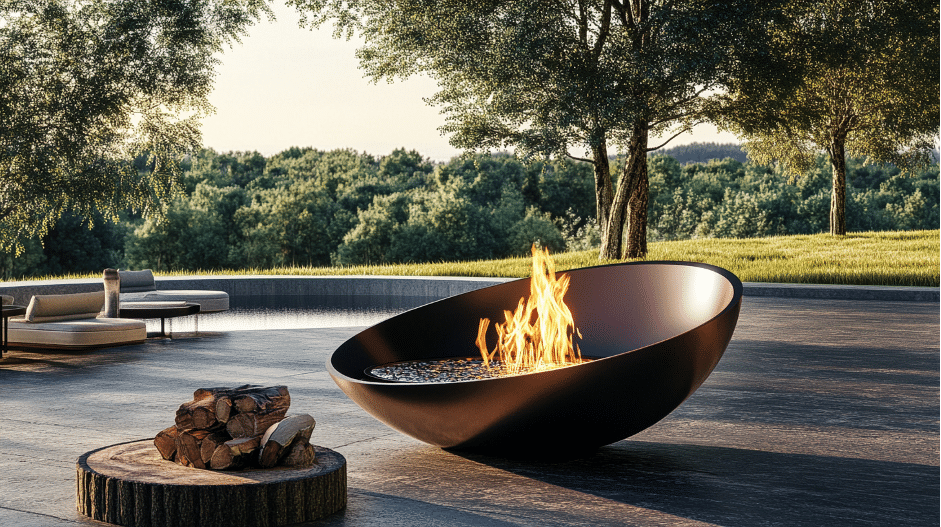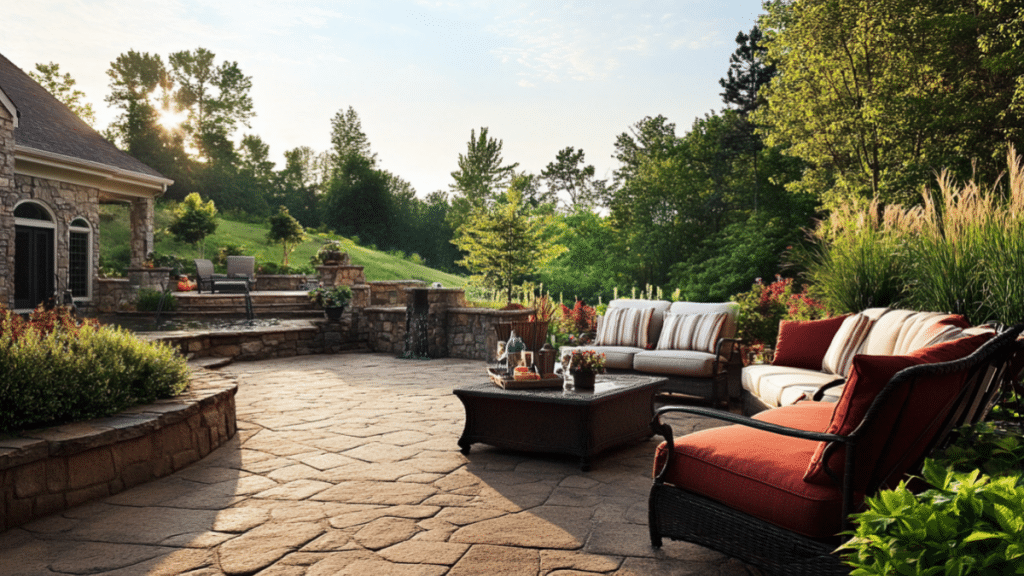Creating the perfect patio space has become essential for modern homeowners seeking to extend their living areas outdoors. When you shop outdoor cushions and furniture, you’ll discover countless possibilities for transforming your patio into a functional and aesthetically pleasing retreat. The key to successful patio design lies in balancing beauty with practicality, ensuring your outdoor space serves both as a visual enhancement to your home and a functional living area.
Planning Your Patio Design
The foundation of an exceptional patio design begins with thorough planning. Consider your space as an extension of your home’s architecture and lifestyle needs. A well-planned patio should seamlessly integrate with your existing structure while providing the functionality you desire for outdoor living.
Essential planning considerations include:
- Space utilization and flow patterns
- Budget allocation for materials and features
- Climate adaptability requirements
- Long-term maintenance capabilities
Material Selection Guide
Selecting the right materials forms the cornerstone of durable and attractive patio design. Natural stone remains a popular choice due to its durability and timeless appeal. Premium materials like limestone and granite offer exceptional longevity while providing distinctive character to your outdoor space.
Porcelain solutions have gained significant popularity in recent years, offering remarkable versatility and minimal maintenance requirements. These materials provide excellent resistance to weather conditions while maintaining their appearance over time. Modern composite materials present an eco-friendly alternative, combining durability with sustainable manufacturing processes.
TOP 10 Design Solutions for Your Patio

The most successful patio designs incorporate elements that enhance both functionality and aesthetic appeal. Let’s explore the top solutions that can transform your outdoor space:
Natural Stone Statement Design
Creating a striking foundation with premium stone materials establishes a sophisticated outdoor environment. Natural stone’s inherent variations provide unique character while ensuring lasting durability. The material’s versatility allows for various pattern layouts and design combinations.
Multi-Level Layout
Implementing different levels in your patio design adds visual interest and creates natural divisions between functional areas. This approach maximizes space utilization while defining separate zones for dining, lounging, and entertaining.
Indoor-Outdoor Flow
Seamless transitions between interior and exterior spaces enhance your home’s overall living area. This design approach focuses on coordinating materials, colors, and architectural elements to create a cohesive environment.
Integrated Lighting Solutions
Strategic lighting placement transforms your patio into an inviting evening retreat. Combining ambient, task, and accent lighting creates layers of illumination that enhance both safety and atmosphere.
Water Feature Integration
Adding water elements brings movement and tranquility to your outdoor space. From simple fountains to elaborate water walls, these features create focal points while providing pleasant background sounds.
Key considerations for successful integration:
- Scale appropriateness
- Maintenance requirements
- Energy efficiency
- Sound levels
Contemporary Container Gardens
Modern container gardening revolutionizes traditional landscaping approaches by offering flexibility and controlled growth. Strategic placement of varied container sizes creates dynamic visual interest while maintaining manageable maintenance requirements. This solution particularly benefits those seeking to incorporate greenery without extensive garden bed installation.
Smart Space Technology
The integration of modern technology elevates patio functionality to new heights. Automated systems for lighting, climate control, and entertainment transform your outdoor space into a sophisticated living area. Smart technology integration allows for seamless control of environmental factors while enhancing comfort and convenience.
Essential smart features include:
- Automated shade controls
- Integrated sound systems
- Smart lighting programs
- Climate monitoring devices
Sustainable Materials
Environmental consciousness drives the selection of sustainable patio materials and features. Modern eco-friendly options combine durability with responsible manufacturing processes, ensuring your outdoor space maintains a minimal environmental impact while providing maximum enjoyment.
Modular Furniture Zones
Flexible furniture arrangements accommodate varying social scenarios and seasonal changes. Modular designs allow for easy reconfiguration, optimizing space usage for different occasions. This approach particularly benefits those who frequently entertain or desire adaptable outdoor living arrangements.
Climate Control Elements
Creating a comfortable environment regardless of weather conditions extends the usability of your patio throughout the year. Thoughtful integration of heating, cooling, and shelter solutions ensures your outdoor space remains enjoyable across seasons.
Design Elements and Layouts
Successful patio design relies on the harmonious arrangement of elements within your available space. Consider traffic flow patterns and functional requirements when determining layout configurations. The relationship between different zones should feel natural and intuitive.
Key layout considerations:
- Activity zone separation
- Traffic flow optimization
- Visual balance
- Privacy requirements
Feature Integration
Incorporating additional features enhances your patio’s functionality and appeal. Each element should serve both practical and aesthetic purposes, contributing to the overall design cohesion. Consider how different features interact and complement each other within the space.
Style-Specific Solutions
Different architectural styles demand unique approaches to patio design. Contemporary designs emphasize clean lines and minimal ornamentation, while traditional layouts focus on symmetry and classic materials. Mediterranean inspiration brings warmth through color and texture combinations.
Popular style elements include:
- Material combinations
- Color palettes
- Architectural details
- Decorative accents
Maintenance and Longevity Tips
Protecting your investment through proper maintenance ensures long-term enjoyment of your patio space. Regular care prevents deterioration and maintains the appearance of materials and features. Establish a maintenance schedule that addresses seasonal requirements and specific material needs.
Frequently Asked Questions
Q: What’s the optimal square footage calculation for different patio functional zones?
A: Professional designers recommend allocating space using the 60-30-10 ratio principle. Primary gathering areas should occupy 60% of total square footage (approximately 25-30 sq ft per person), secondary zones like dining spaces require 30%, and transition areas need 10%. For example, a 400 sq ft patio should dedicate 240 sq ft to primary living space, 120 sq ft to dining, and 40 sq ft to transitions and pathways. Always maintain minimum clearances of 36 inches for circulation paths per universal design standards.
Q: How do I determine the appropriate load-bearing capacity for different patio materials?
A: Calculate your patio’s structural requirements using PSI (Pounds per Square Inch) ratings. Natural stone pavers typically require a minimum compressive strength of 8,000 PSI, while porcelain pavers need at least 1,800 PSI for residential applications. The substrate should maintain a minimum CBR (California Bearing Ratio) of 5% for proper load distribution. Factor in local soil conditions and frost depth requirements when determining base material depth.
Q: What are the most weather-resistant material options for extreme climate conditions?
A: Select materials based on their Weather Performance Index (WPI) and frost resistance ratings. Vitrified porcelain with a water absorption rate below 0.5% and a PEI rating of IV or V offers superior weather resistance. For natural stone, opt for dense granites with absorption rates under 0.4% and compressive strength exceeding 20,000 PSI. Consider materials with a coefficient of thermal expansion below 6.5 x 10^-6/°C to minimize seasonal movement and potential cracking.
Conclusion
Creating an exceptional patio space requires thoughtful planning, quality materials, and attention to detail. By incorporating these top design solutions while considering your specific needs and preferences, you can create an outdoor living space that enhances both your property value and lifestyle enjoyment. Remember that successful patio design balances aesthetic appeal with practical functionality, ensuring your outdoor space serves as a natural extension of your home.
